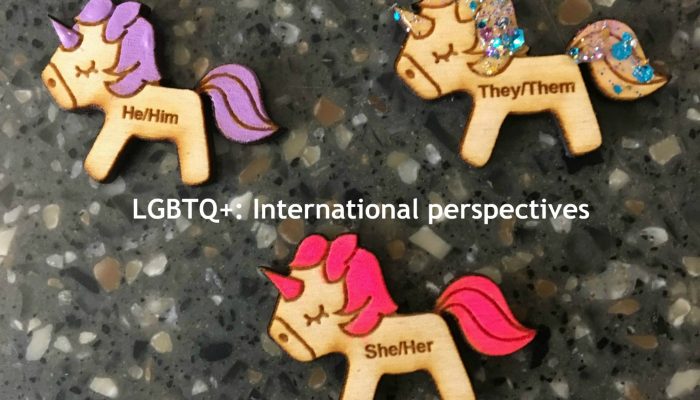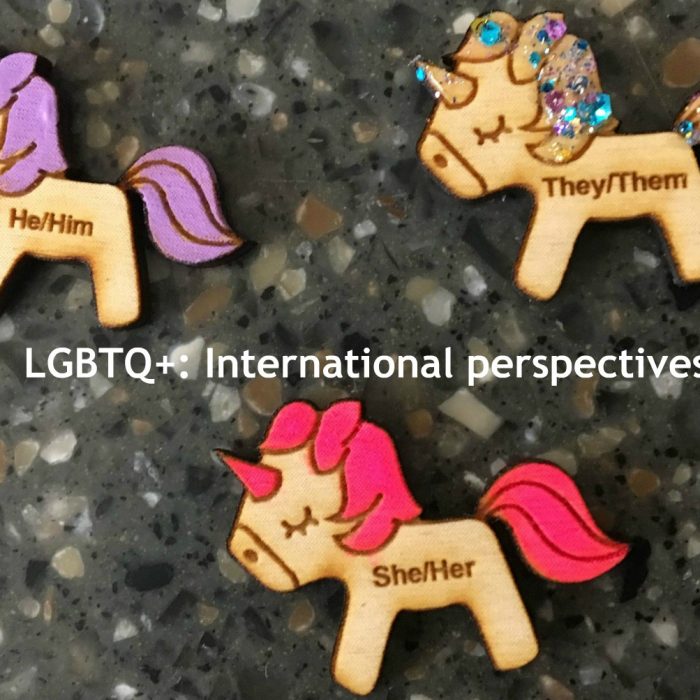Are there hard-and-fast rules for libraries engaged with LGBTQ+ communities? While there are areas where there should be clear guidance, there are others where context is more important.

Welcoming LGBTQ+ people
How can we demonstrate, through action, that LGBTQ+ people are welcome in libraries?
In the first article in this limited series of conversations, Amanda Wilk and John Vincent will explore this question by looking at how well libraries are providing for LGBTQ+ people. These conversations will take place over the next two years, include six articles, and are “cross border”: Amanda is working in Canada while John is an LGBTQ+ advocate based in the U.K.
Throughout the series, John and Amanda will use the acronym LGBTQ+ to refer to lesbian, gay, bisexual, transgender, queer/questioning and other identities within our community. We would like to acknowledge that other acronyms are also used, and that sexual and gender expressions are diverse and impossible to represent within the confines of five letters.
For more information and terminology related to LGBTQ+ identities, the 519’s Glossary of Terms is a valuable resource. Let the talks begin … and we hope you will join in through your comments and feedback.
John Vincent (J.V.)
Library staff often talk about being “open to all,” but are libraries really open? Back in 1999/2000, in the U.K., a ground-breaking research project—the project report was actually called Open to all?—showed that this was very far from the case, and that there was a huge number of barriers to the take-up of library services by many people, especially those who were already socially excluded.
A lot has happened since then, not all of it good! While recognition of the barriers has led to removing some of them, some remain and have been joined by new barriers. Focusing specifically on the library and information needs of LGBTQ+ people, there are still several real or potential barriers. These include:
- Cuts to library provision, which, as well as actual library closures, also includes reductions in materials-buying budgets, and staff. (In the U.K., Ian Anstice’s Public Libraries News records details of these.)
- Staff attitudes and/or their lack of awareness of the needs of LGBTQ+ people—the report by Kerry Wilson and Briony Birdi, The right ‘man’ for the job? The role of empathy in community librarianship, illustrates this.
- The legacy of “Clause 28”: Clause 28 was passed into law in 1988, as part of the Local Government Act 1988: Chapter 9, and stated that a local authority “shall not intentionally promote homosexuality or publish material with the intention of promoting homosexuality” or “promote the teaching in any maintained school of the acceptability of homosexuality as a pretended family relationship.” It was repealed in Scotland in 2000, but not until 2003 in the rest of the UK. Whilst the law itself was barely used, its effect was severe—much LGBTQ+ provision, e.g., by libraries, was stopped (for fear of prosecution); many schools did not include LGBTQ+ at all in sex and health education (and you still meet 30- and 40-somethings who never covered this at school); and there are people working in libraries (and other organisations) who think Clause 28 is still in force.
Are there parallels in Canada?
 Photo credit: James Sutton on UnSplash
Photo credit: James Sutton on UnSplash
Amanda Wilk (A.W.)
There are. The Open to All report served as a foundational document for the community-led libraries movement in Canada. Recognizing that though it is the goal of public libraries to be open to all, they have not and are still not accessible to everyone in the community, community-led libraries utilize a community development-based approach to build relationships in the community to understand and assess the needs of those who do not currently use their services. Community-led libraries understand that those who can benefit most from library services are often people who use libraries the least or not at all, and employ an equity-based framework to reach them.
Though we aim to welcome everyone to use our libraries, we cannot be aware of barriers to access unless we work directly with marginalized groups. It is also important to recognize that sometimes before a person or community can feel that they are welcome, they need to first be invited in. Adopting a community-led framework allows library workers to move beyond our physical buildings to do this.
As you mention, staff attitudes and awareness of the needs of LGBTQ+ people can be a significant barrier. In particular, a lack of understanding and awareness of gender identities can lead to negative interactions between library staff and LGBTQ+ people including:
- Misgendering, or ascribing the wrong pronouns to individuals, or in group settings such as story times which may start with a leader welcoming boys and girls to the program (which makes children choose between two options in the gender binary that can cause confusion, worry or stress for gender-creative or trans kids)
- Requiring gender creative and transgender people to provide their legal name and select a gender (with male and female often presented as the only options) when registering for library cards
Furthermore, unless library staff are explicit in their support and promotion of LGBTQ+ materials, customers may feel uncertain as to whether their library will meet the information needs they have that relate to their sexual and/or gender identity. As libraries offer free access to reliable knowledge, which might not be accessible to LGBTQ+ people in any other setting, ensuring that we not only have an expansive breadth of content, but that we are explicit in our promotion of these resources and of LGBTQ+ identities is crucial.
J.V.
In the U.K., the effect of all this is to make services patchy. Some libraries provide a terrific range of stock, looking at the needs of all those included under the LGBTQ+ ‘umbrella’, whilst others have just a few books available at any one time.
Some provide activities and events, for example celebrating LGBT History Month in February, and Pride (different times throughout the year, depending on location), and commemorating the International Day Against Homophobia, Transphobia and Biphobia (IDAHOBIT) in May.
Some also include books and other materials for children and young people (and this is an area that has grown recently, at least in terms of the number of books available—researcher Elizabeth Chapman has produced a list of material available for children and young people), and, as in the US, a few libraries (e.g., Bristol) are introducing drag queen storytelling!
What’s the current position in Canada?
A.W.
Many libraries do a wonderful job of ensuring LGBTQ+ materials exist within our collections. However, the breadth of resources available, and in particular the ways in which libraries promote these materials and make them accessible to the community varies. Resources like We Need Diverse Books, Rainbow and Over the Rainbow booklists, the Lambda Literary and Stonewall book awards make it easier to find LGBTQ+ books; however, a Canada-specific equivalent does not exist.
Libraries might dedicate display space and resources to promoting LGBTQ+ content during Pride month; however, more needs to be done to ensure LGBTQ+ materials are integrated into library displays and programming year-round.
We are also beginning to see more libraries offering programming for or that highlights LGBTQ+ identities. Canadian libraries are also beginning to offer Drag Queen story times, and some are opening spaces for LGBTQ+ youth to meet and build community. It is important that we continue to see more programming reflective of or meant to create welcoming space for LGBTQ+ people.
 Photo credit: Toa Heftiba on UnSplash
Photo credit: Toa Heftiba on UnSplash
J.V. & A.W.
Given all this, it is clear that libraries do still need to demonstrate though action that LGBTQ+ people are welcome. We suggest the following (as a basic minimum):
- Make libraries—as public spaces—welcoming.
- Provide access to gender neutral washrooms.
- Showcase support for LGBTQ+ people by displaying rainbow flags or stickers.
- Host programs, and exhibitions.
- Develop and promote a comprehensive LGBTQ+ collection.
- Have LGBTQ+ people on staff, and train all staff on LGBTQ+ identities.
- Make LGBTQ+ provision much more visible—again, materials, staff, events and activities.
- Simplify joining procedures, and have a procedure in place for registering gender creative and transgender people.
- Develop and build on links with the community, and welcome LGBTQ+ community organizations into library spaces through partnerships.
- Reach out to the LGBTQ+ community by offering outreach with LGBTQ+ organizations.
- Ensure that any issues arising are clearly dealt with.
Thoughts?
Amanda Wilk is a community librarian at Burlington Public Library. She can be reached at wilka@bpl.on.ca
John Vincent is the networker for The Network – tackling social exclusion, based in the U.K. John can be reached at john@nadder.org.uk.
